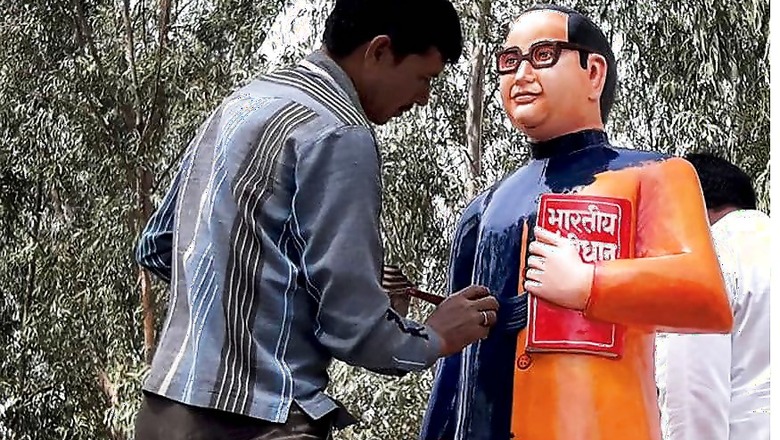
views
New Delhi: Two days after a saffron coloured statue of BR Ambedkar was unveiled in Unnao, Uttar Pradesh, a local Bahujan Samaj Party leader painted it blue on Tuesday morning.
It was on April 7 that the statue was vandalised by unidentified people. A day later, to assuage the growing resentment among Dalits, on account of a large scale destruction of Ambedkar statues, the original was replaced by a new installation.
Only this time, Ambedkar was seen wearing a bright orange coloured suit in place of the usual blue.
BSP's Hemendra Gautam was the person who got the statue painted again in blue. When asked for reasons, he did not offer any.
But why the need to paint and maintain Ambedkar in blue and not let it remain suited in red, the symbol of sacrifice in Hinduism, which is identified usually with RSS, its various outfits, and the BJP?
Why is the colour blue associated with Dalit movements and with political parties focused on Dalit issues like Republican Party of India (RPI), RPI (Athawale) and BSP? Why, for instance, protests held by Dalits during April 2 ‘Bharat Bandh’ were held under the blue banner?
One reason could be historical accuracy. An undisputed fact about BR Ambedkar, the father of the Indian constitution and of several Dalit movements across India, is that he always wore a blue coloured suit and often paired it with a red tie.
But the fact that the most popular Dalit icon of India - Ambedkar - wore a blue suit is only half the answer to our question. The other half is provided in an academic paper titled 'Fabric-Rendered Identity: A Study of Dalit Representation in Pa. Ranjith’s Attakathi, Madras and Kabali' published in the Artha-Journal of Social Sciences, as reported in a news article in Livemint.
The paper studies the representation of Dalits in the three popular Bollywood movies, and affirms that it is "seen as an important paradigm in the explicit representation of Dalit empowerment in films and is often used by Dalit communities especially in protests and rallies as a mark of empowerment”.
It goes on to say that "Ambedkar is known to have introduced the blue Mahar's Flag as his party flag for the Independent Labour Party", setting the (colour) tone for all future Dalit based political ventures.
But the painting and re-painting of Ambedkar’s statue is part of a bigger political tussle, a pull by BJP government in Uttar Pradesh and a pushback of sorts from Dalits and Dalit focused political parties.
Ever since the new Chief Minister Yogi Adityanath assumed responsibilities at Lucknow, he has been on a relentless drive to paint hospitals, parks, state secretariat buildings, police complexes, state buses and even madrassas saffron.
“The government is busy doing politics of colour. And now they are getting exposed by changing the colour of Ambedkar statues to saffron. This is not going to help them; instead, people will know their intentions better now,” Samajwadi Party MLA and spokesperson Sunil Singh Sajan told News18.
The Adityanath government has also made attempts to own ‘Ambedkar’ by moving an amendment to add Ramji to Ambedkar’s name.
Who, between ‘blue’ and ‘saffron’, has greater claim over Ambedkar may be left to the upcoming general elections. But the next most important question may be answered shortly – will Ambedkar’s Unnao statue be re-re-painted saffron?



















Comments
0 comment